|
|
|
Birds of Europe, North Africa and the Middle East: An Annotated ChecklistDominic Mitchell
Lynx Edicions
2017
"This is the most up-to-date checklist of bird species and subspecies recorded in Europe, North Africa and the Middle East, including Iran and the Arabian Peninsula – the 'greater' Western Palearctic. Species are presented in systematic order, and each species entry includes scientific and English names, taxonomic notes, distribution and range/vagrancy occurrences within the region. In addition to the main list of almost 1,150 species, appendices detail regionally endemic and extinct birds, those no longer considered to have occurred, and the national lists of all regional countries. The first major update for Europe, North Africa and the Middle East since the Birds of the Western Palearctic series came to an end two decades ago, this long-awaited checklist is essential reading for all those with an interest in the 'WP' and its avifauna."
|
Buy from amazon.co.uk 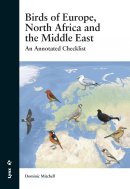
|
|
Birds of Europe, North Africa and the Middle East: A Photographic GuideFrédéric Jiguet, Aurélien Audevard
Translation: Tony Williams
Princeton University Press
2017
"The first comprehensive pocket-sized photographic field guide to every bird species in Europe - this includes winter visitors and common migrants but also all rarities to the region, even if they have been recorded only once. The guide also covers hypothetical species - those that have a good chance of being recorded due to such factors as range expansion and changing weather patterns. The book's 2,200 stunning color photographs mean that every species is pictured, making field identification quick and easy. Succinct text covers key identification features, voice, habitat, and distribution, and distribution maps are provided for regular breeding species. Particular attention and details are given to help differentiate similar-looking species. Lavishly illustrated, up-to-date, and wide-ranging, Birds of Europe, North Africa, and the Middle East is an essential field guide for every naturalist and birder."
|
Buy from amazon.co.uk 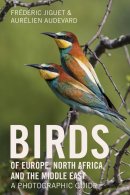
|
|
Identification of European Non-PasserinesJeff Baker
BTO Field Guide
BTO
2016
"This major guide improves on the original by now comprehensively covering 155 species, with descriptions of ageing and sexing methods, moult, biometrics and racial differences. It complements Lars Svensson's Identification Guide to European Passerines, and is an invaluable reference for Bird Ringers, keen birders and feather enthusiasts, alike."
|
Buy from amazon.co.uk 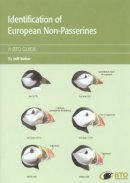
|
|
Top Birding Sites of EuropeDominic Couzens
New Holland
2011
"If you have ever dreamt of seeing Snowy Owls in Norway, spectacular raptor migration by the Black Sea, Wallcreepers in the Pyrenees or seabird cities off Scotland, then this book and CD package is for you. Top Birding Sites of Europe features more than 30 detailed accounts of the continent's finest bird locations, from the famous Camargue and Coto Donana, to some less well known but no less productive destinations. The expertly written and very readable text is backed up by lavish photos of the birds and scenery at each of the chosen hot-spots, including rare images of amazing species and some of the continent's most stunning avian spectacles. A CD of key bird sounds complements the entries on each site. Whether you want to use it to plan your holidays for years to come, or just as an inspirational book to dip into, Top Birding Sites of Europe will have a wide appeal for all those with an interest in birds."
|
Buy from amazon.co.uk 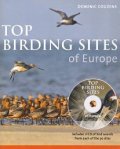
|
|
Collins Bird Guide (2nd Edition)Lars Svensson
Illustrations: Killian Mullarney and Dan Zetterstrom
Collins
2010
"The book provides all the information needed to identify any species at any time of the year, covering size, habitat, range, identification and voice. Accompanying every species entry is a distribution map and illustrations showing the species in all the major plumages (male, female, immature, in flight, at rest, feeding: whatever is important). In addition, each group of birds includes an introduction which covers the major problems involved in identifying or observing them: how to organise a sea watching trip, how to separate birds of prey in flight, which duck hybrids can be confused with which main species. These and many other common birdwatching questions are answered. The combination of definitive text, up-to-date distribution maps and superb illustrations, all in a single volume, makes this book the ultimate field guide, essential on every bookshelf and birdwatching trip."
|
Buy hardback from amazon.co.uk Buy paperback from amazon.co.uk 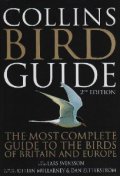
|
|
Birds Of Europe (2nd Edition)Lars Svensson
Illustrations: Killian Mullarney and Dan Zetterstrom
Princeton University Press
2010
"Since it was first published a decade ago, Birds of Europe has become the definitive field guide to the diverse birdlife found in Europe. Now this superb guide has been brought fully up to date with revised text and maps along with added illustrations. Uniquely designed for easy use in the field, this expanded edition covers all 772 species found in the region as well as 32 introduced species or variants and 118 very rare visitors. Detailed species accounts describe key identification features, voice, habitat, range, and size. More than 3,500 full-color illustrations depict every species and all major plumage variations, and color distribution maps provide breeding, wintering, and migration ranges for every species."
|
Buy from amazon.co.uk 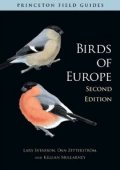
|
|
Advanced Bird ID Guide: The Western PalearcticNils Van Duivendijk
New Holland Publishers
2010
"This innovative guide will be an essential addition to the library of any serious birder. It accurately describes every key detail of every plumage of all 900 species that have ever occurred in Europe, North Africa and the Middle East - the region known to all birdwatchers as the Western Palearctic. Its level of detail is unprecedented for a book of this size, and it will be sought after by all bird enthusiasts. A large number of existing bird field guides cover Europe and the Western Palearctic. This, however, is a guide with a difference. It has no colour plates or illustrations, but instead its unique selling point is that for every species the detailed text lists the key characters of each recognizable plumage, including male, female, immature, juvenile, all subspecies and all other variations. This level of detail includes, for example, all eleven forms of Canada Goose and all nine forms of Yellow Wagtail known in the region. In the past such in-depth detail has only been available in huge multi-volume tomes such as Birds of the Western Palearctic. "The Advanced Bird Guide" enables birders to take this information into the field for the first time."
|
Buy from amazon.co.uk 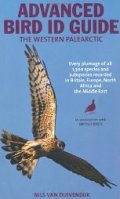
Buy from amazon.co.uk
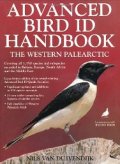
|
|
Birds of the Palearctic: Non PasserinesNorman Arlott
Collins
2009
"This is the essential companion for the keen birdwatcher. Together with the volume on passerines, published in 2007, this book covers all the non-perching birds of the Palearctic, a zoographical area running from the British Isles eastwards to Japan, with its southern border marked by the Sahara, the Middle Eastern deserts, and the Himalayas. It covers the whole of the Russian Arctic, China, Tibet, Japan and the whole of Europe - the most popular birdwatching area in the world. Every non-passerine species found in this wide area is illustrated in every plumage in which they can be seen in the wild. Author and illustrator Norman Arlott is one of the world's leading bird artists and has seen nearly all of the 1,800 species featured. The accompanying text concentrates on the specific characteristics and appearance of each species that allow identification in the field, including voice. Every species also has a distribution map - in many cases the first time this has been compiled for the area."
|
Buy from amazon.co.uk 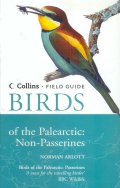
|
|
European Bird GuidePeter H. Barthel, Paschalis Dougalis
New Holland
2008
"This comprehensive field guide covers more than 500 bird species, including all those that commonly breed, pass through or winter in Britain and Europe, plus a number of regular vagrants. It has 70 beautifully illustrated and very accurate full-page colour plates illustrating a variety of plumages and poses for most species. In total the book contains 1,700 bird images. The concise text is packed with essential information on the identification, calls, distribution and status of each species and the account for each species is on the page opposite its illustration. There is a distribution map for most species.The book's combination of authority and portability make it an essential field companion for any European birdwatcher. It is more up-to-date than its nearest competitors and includes the latest taxonomic 'splits' such as Caspian Gull, Yelkouan Shearwater, Balearic Warbler and Iberian Green Woodpecker. In addition it is less expensive and much more portable than these other titles, being lighter and more pocket-sized. The introduction includes an overview of bird families, while there is a section on birdsong at the end of the book."
|
Buy from amazon.co.uk 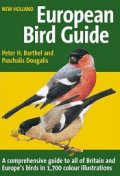
|
|
Great Birds of Britain and Europe: 200 Star SpeciesJonathan Elphick and David Tipling
Duncan Baird Publishers
2008
"Concentrating on 200 really special birds of Britain and continental Europe, from Swans to Buntings, "Great Birds of Britain and Europe" is a marvellous celebration of the beauty of birds through the lens of dedicated and highly skilled photographers. The stunning images, although apparently spontaneous, are often the product of hours - even days - of patient fieldcraft and pure determination and stamina on the photographer's part. They capture the excitement of the birds - the thing that anyone watching them closely would find most compelling: a black-tailed Godwit performing its balletic display, two Golden Eagles fighting in mid-air. The text evocatively catches the key characteristics of each bird and, with the help of thumbnail colour maps, pinpoints its distribution and rarity status. For each species shown the author always offers fascinating facts that even a keen naturalist or birdwatcher might not already know. Most of the birds chosen are ones that enthusiasts are particularly pleased to see - whether because they are elusive, because they are special to their habitat or region, or simply because they are supremely beautiful."
|
Buy from amazon.co.uk 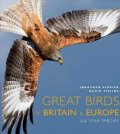
|
|
A Climatic Atlas of European Breeding BirdsBrian Huntley, Rhys E. Green, Yvonne C. Collingham and Sophia G. Willis
Lynx Edicions / RSPB / University of Durham
2007
"An exploration of the relationships between the distributions of birds breeding in Europe and the climate, and how future climatic change may alter each species' potential breeding distribution. It presents the results for 431 species. It also includes brief accounts for a further 48 native and 16 introduced species."
|
Buy from amazon.co.uk 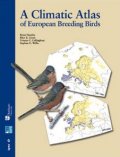
|
|
Birds of the Palearctic: PasserinesNorman Arlott
Collins
2007
"This is the essential companion for the keen birdwatcher. This book covers all the perching birds of the Palearctic, a zoographical area running from the British Isles eastwards to Japan, with its southern border marked by the Sahara and middle Eastern deserts, and the Himalayas. It covers the whole of the Russian Arctic, China, Japan and the whole of Europe - the most popular birdwatching area in the world. Every passerine species found in this wide area is illustrated in every plumage in which they can be seen in the wild. Author and illustrator Norman Arlott is one of the world's leading bird artists and has seen nearly all of the 1,800 species featured. The accompanying text concentrates on the characteristics and appearance of each species that allow identification in the field (including voice). Every species will also have a distribution map - in many cases the first time this will have been compiled for the area."
|
Buy from amazon.co.uk 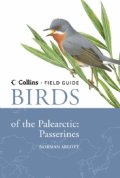
|
|
Birds of Europe: With North Africa and the Middle EastLars Jonsson
Christopher Helm
2005
Latest edition of the Jonsson guide. "This guide covers all but a few of the Western Palearctic's breeding birds, and includes information on all regularly encountered vagrants. It has over 400 colour plates and, with distribution maps and illustrations on facing pages, it is practically designed and easy to use."
|
Buy from amazon.co.uk 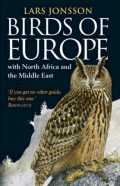
|
|
Birds in European CitiesEditor: John G. Kelcey and Goetz Rheinwald
Ginster Verlag
2005
"Birds in European Cities is the first book to describe any aspect of the natural history of man-made habitats across Europe or any other continent. The urban habitats present in the cities have arisen by a combination of their geographical and climatic position and their development over the last 1,000 years. Each chapter describes the historical development of the city, the birdlife that has been recorded in it from the beginning of the 20th Century, the birds found in each of the major habitats; and a section on where to watch birds. The chapters also consider the effects of planning and architectural and landscape design on birds. The implications of building restoration and landscape and management on the birdlife of the cities are also described. Many interesting facts emerge. For example, there is only one truly urban bird - the Feral Pigeon, which has evolved from the adaptation of and considerable genetic changes in the Rock Dove to become the only bird whose occurrence is restricted to urban areas. The overall species diversity and biomass of birds in the urban environment is higher than in the rural environment. In contrast, the abundance and diversity of species within a particular habitat is significantly lower in cities than in the countryside."
|
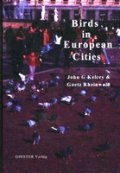 |
|
Birds in Europe: Population Estimates, Trends and Conservation StatusEditors: Ian Burfield and Frans van Bommel
BirdLife Conservation Series 12
BirdLife International
2004
"In 1994, BirdLife International published the landmark "Birds in Europe: their Conservation Status" - the first ever review of the conservation status of all regularly occurring European birds. This book rapidly became a cornerstone of BirdLife's conservation work and is widely used by the European Commission, national governments and NGO's. Fully updated, "Birds in Europe: Population Estimates, Trends and Conservation Status" covers the European continent from Greenland in the west to the Urals in the east, and from Svalbard in the north to the Canary Islands in the south, including Balkan and Caucasian countries where political instability made data collection impossible in 1994. Setting a new standard for conservation data, "Birds in Europe" (1994) was highly praised for the depth and breadth of its research. Monitoring programmes established since then have provided an even higher accuracy and quality of data for "Birds in Europe" (2004). Full population data is included on all 526 species regularly occurring in Europe. Half a page is devoted to each species, including an illustration, distribution map, population and trends data, status information, and a concise summary of its status across Europe."
|
Buy from amazon.co.uk 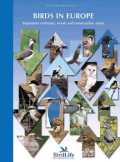
|
|
Birds of Britain and EuropeGuy Mountford, P.A.D. Hollom, Roger Tory Peterson
Collins
2004
The latest revision of a work that was first published 50 years ago. Describes nearly 700 species with over 1500 colour illustrations. Distribution maps show the breeding range and winter range for each species. In the case of confusable species, additional notes draw attention to their distinction from those with which they are most likely to be confused. Descriptions also include how to identify birds in flight and offers a concise introduction of what to look for when trying to distinguish different species.
|
Buy from amazon.co.uk 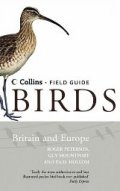
|
|
The Hamlyn Guide to Birds of Britain and EuropeBertel Brunn, Hakan Delin and Lars SvenssonIllustrations: Arthur Singer and Dan Zetterstrom
Bounty Books
2004
"A new revision of the most authoritative and up-to-date identification guide to all the birds of Britain and Europe. Over 530 birds illustrated in full colous. Over 465 distribution maps and 140 line drawings. Completely new introduction, describes basic field techniques and common identification errors."
|
Buy from amazon.co.uk 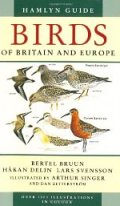
|
|
Birds of Britain and Europe Roger Tory Peterson, Guy Mountford, P.A.D. Hollom,
Peterson Field Guides
Houghton Mifflin
2001
The latest revision of a work that was first published nearly 50 years earlier. Describes nearly 700 species with over 1500 colour illustrations. Distribution maps show the breeding range and winter range for each species. In the case of confusable species, additional notes draw attention to their distinction from those with which they are most likely to be confused. Descriptions also include how to identify birds in flight and offers a concise introduction of what to look for when trying to distinguish different species.
|
Buy from amazon.co.uk 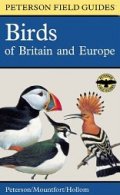
|
|
Collins Bird Guide: The Most Complete Guide to the Birds of Britain and EuropeLars Svensson, Peter J. Grant, Killian Mullarney, and Dan Zetterstrom
Collins
2001
This guide provides all the information needed to identify any species at any time of the year, with detailed text on size, habitat, range, identification and voice. Accompanying every species entry is a distribution map and numerous illustrations to show the species in all the major plumages (male, female, immature, in flight, at rest, feeding, etc). Each group of birds has an introduction, which covers the major problems involved in identifying or seeing them, including: how to organize a sea watching trip; how to separate birds of prey in flight; and which duck hybrids can be confused with which species.
|
Buy from amazon.co.uk 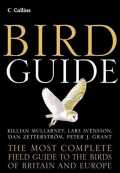
|
|
European Bird Populations: Estimates and TrendsMelanie Heath, Carolien Borggreve and Nicholas Peet
BirdLife Conservation Series 10
BirdLife International
2001
"The publication of European Bird Populations: Estimates and Trends means that, for the first time, all pan-European data on bird populations and their distribution are available in one book. The information provided acts as a supplement to information given in two previous BirdLife International publications: Birds in Europe: Their Conservation Status and The EBCC Atlas of European Breeding Birds: Their Distribution and Abundance. Full population data is presented on all 515 regularly occurring species in Europe with line illustrations for each species. Information on population trend and range trend data is provided, along with status threat summaries and population size estimates for each species."
|
Buy from amazon.co.uk 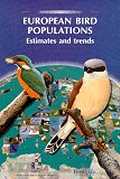
|
|
Birds Of EuropeLars Svensson, Killian Mullarney, Dan Zetterstrom, Peter J. Grant
Princeton University Press
2000
"Birds of Europe is an extraordinary new field guide to the diverse bird life found throughout Europe. Ranging from the Urals to the Atlantic and from Scandinavia to the Middle East, the guide covers the 722 bird species found in the region as well as 23 introduced species or variants and 103 very rare visitors. The text by Lars Svensson and Peter J. Grant provides all of the information needed to identify any species in Europe at any time of year, covering identification, voice, habitat, range, and size. In addition, the authors provide an introduction to each group of birds that addresses the major problems involved in identifying or observing the group: how to separate birds of prey in flight, how to organize a sea watching trip, which duck hybrids can be confused with which main species. In over 3,500 illustrations, Killian Mullarney and Dan Zetterstrom depict every species as well as all major plumage variations. The artists also introduce several design innovations. They illustrate typical habitats and characteristic behavior, including birds in flight, feeding, hunting, and perching; they add pointers and captions to the plates to show key field marks; and they arrange birds for easy comparison of confusing plumages. Distribution maps give up-to-date breeding, wintering, and migration ranges for every species. The combination of definitive text, superb illustrations, and innovative design, all in a single, portable volume, makes this book the ultimate field guide to the birds of Europe. On the bookshelf or in the coat pocket, it will become an essential companion for every birder, ornithologist, and traveler to Europe."
|
Buy from amazon.co.uk 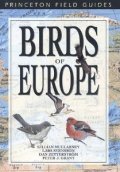
|
|
Where to Watch Birds in Europe and RussiaNigel Wheatley
Christopher Helm
2000
"Over 250 major sites are treated in this book, and many more in passing from Iceland across Europe through Georgia to Ussuriland in southeast Russia. Countries, archipelagos and islands are treated alphabetically, the introduction to each being accompanied by a map showing major routes and the distribution of sites. Each site account lists the birds to be seen and how and where to find them, particularly the specialities, and there is also information on other wildlife and tips on finding accommodation. There is a general introduction to the region, a list of useful addresses to aid in planning and researching a trip as well as a site index and, most importantly, a species index which will enable readers to pinpoint the birds they most want to see."
|
Buy from amazon.co.uk 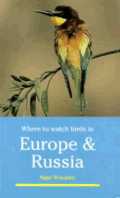
|
|
Where to Watch Birds in Europe and RussiaNigel Wheatley
Princeton University Press
2000
"Nigel Wheatley continues his continent-by-continent guide to the best locales for international birding by turning his binoculars to over 250 of the most productive birding sites in Europe and Russia. Whether you want to know how Golden Eagles are distributed on the Scottish Island of Skye, which birds you'll find in the botanical gardens in Minsk, or where to go if you have your heart set on a Grey Phalarope or Lapland Bunting, this book is the essential travel companion. Though compact and portable, Where to Watch Birds in Europe and Russia contains a tremendous amount of information on travel, geography, and bird distribution that can be used to plan a trip from scratch or get more out of any itinerary. Wheatley gives excellent coverage not only of the well-trod fields of England and France, but also of countries newly explored by North American birders (such as Romania and Azerbaijan), such bird-rich microclimates as Malta and Greece's Strymon Delta, and several often-overlooked small nations (such as Luxembourg and Moldova)."
|
Buy from amazon.co.uk 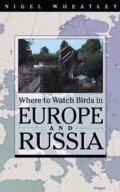
|
|
Important Bird Areas in Europe: Priority Sites for ConservationEditors: M.F. Heath, M.I. Evans, D.G. Hoccom, A.J. Payne and N.B. Peet
BirdLife Conservation Series 8
BirdLife International
2000
"This 2 volume, 1600 page book provides comprehensive coverage of the 3,619 most important sites for bird conservation in 51 European countries, equivalent to seven percent of the continent's land area. Each country's entry is the work of one to three local experts. Key species, habitats and conservation issues are discussed for every site, with thumbnail location maps. Hundreds of graphics, maps and data tables show key information at national and regional levels. An essential guide for policy-makers and developers, conservationists and environmental consultants, and a call for action to national governments, who have left 40 percent of these sites with no legal protection. Volume 1 (Northern Europe) covers Volume 1 covers: Austria, Belarus, Belgium, Czech Republic, Denmark, Greenland, Estonia, Finland, Germnay, Scotland, Latvia, Liechtenstein, Lithuania, Luxembourg, Netherlands, Norway, Farao Islands, Svalbard, Poland, Republic of Ireland, Russia, Slovakia, Sweden, Switzerland, United Kingdom. Volume 2 (Southern Europe) covers Albania, Andorra, Armenia, Azerbaijan, Bosnia, and Herzegovina, Bulgaria, Croatia, Cyprus, France, Georgia, Gibraltar, Greece, Hungary, Italy, Macedonia, Malta, Moldova, Portugal, Azores, Madeira, Romania, Slovenia, Spain, Turkey, Ukraine, Yugoslavia."
|
Buy v1 from amazon.co.uk 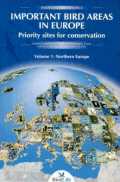
Buy v2 from amazon.co.uk
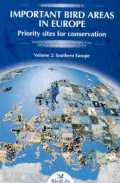
|
|
A Field Guide to the Raptors of Europe, the Middle East and North AfricaWilliam S. ClarkIllustrator: N. John Schmidt
Oxford University Press
1999
"In this comprehensive new identification guide, Bill Clark presents the latest information on tried and tested field marks for identifying the diurnal raptors, both perched and in flight. Many of these field marks are the result of his own extensive experience in identifying raptors, and have never before been published. Forty-eight stunning colour plates, especially painted for this volume by artist N. John Schmitt, depict all the plumages for every raptor found in the Western Palearctic region, both regularly occurring and vagrant. The plates are augmented by a forty-page colour photograph section. The accompanying text provides the essential clues to identification. These include detailed plumage descriptions for each age, sex, and colour morph, as well as sections describing flight, moult, behaviour, and distribution for every species. The text also contains useful sections on similar species - notoriously difficult to identify - and how to distinguish them. Each account concludes with the range of measurements for length, wing span, and weight."
|
Buy from amazon.co.uk 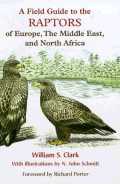
|
|
The Handbook of Bird Identification for Europe and the Western PalearcticMark Beaman and Steve Madge
Illustrations: Hilary Burn, Martin Elliott, Alan Harris, Peter Hayman, Laurel Tucker, and Dan Zetterstrom
Christopher Helm
1998
868 pages, 357 colour plates, 625 colour maps
"A bird identification guide that includes all of the nearly 900 species that have occurred in Europe and the Western Palearctic region. The species are organised by family, with each family section comprising an introduction followed by species accounts and colour plates for the species in the family. There are also colour distribution maps for 625 species."
|
Buy from amazon.co.uk 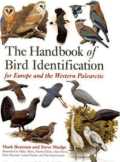
|
|
The Handbook of Bird Identification for Europe and the Western PalearcticMark Beaman & Steve Madge
Princeton University Press
1998
"Drawing on their unrivaled field experience in Europe, the Middle East, and North Africa, authors Mark Beaman and Steve Madge have combined forces with some of Europe's finest bird artists to produce the region's most comprehensive guide ever. This is the first book to cover every species to have occurred in the region, including vagrants and accidentals - nearly nine hundred species in total. Color illustrations depict each bird and its main plumage stages and subspecies. An extensive text explains all aspects of identification, status, and habitat, while full-color maps within the text offer detailed distributional information. During the compilation of this book, Beaman and Madge traveled throughout the region, from Iceland and Siberia to the Cape Verde Islands, Egypt, and Georgia. Their field experience is reflected in the breadth and accuracy of the information presented in this guide and in the thorough treatment of difficult or little-known groups. The innovative design of the book makes it accessible to beginning and expert birdwatchers alike. The Handbook of Bird Identification for Europe and the Western Palearctic is the ultimate reference guide for every birdwatcher interested in the region."
|
Buy from amazon.co.uk 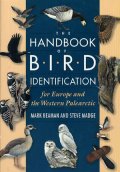
|
|
The EBCC Atlas of European Breeding Birds: Their Distribution and AbundanceEditor: Ward J.M. Hagemeijer and Michael J. Blair
Poyser
1997
"This landmark volume presents, for the first time, an integrated picture of the distribution and abundance of the breeding birds of Europe. The survey data, gathered by over 10,000 field ornithologists from every European country, in over 100 regional and national atlas projects, has been combined and mapped to show the presence or absence of 495 species in over 4400 50 x 50 km squares, many with data showing the present population size. The accompanying text written by a team of 450 authors in 38 countries elaborates on the mapped information, and presents data on a further 62 species too localised to map effectively. An international team of artists has provided lively illustrations of the mapped species."
|
Buy from amazon.co.uk 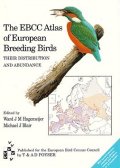
|
|
Birdwatching: The Ultimate Guide to the Birds of Europe Arnoud Van den Berg, Tom Van der Have, Guido Keijl and Dominic Mitchell
Harper Collins
1997
"Compiled by a panel of expert ornithologists and packed with advice, illustrations and practical information, this valuable reference book is broken down into four key sections, covering: origins, anatomy, behaviour, migration and habitat; birdwatching at home; birdwatching in the field, with advice on equipment, basic identification, recognising songs and calls, photography, and the best birdwatching sites; and lastly, a section looking at the various species of birds that are found in different habitats."
|
Buy from amazon.co.uk 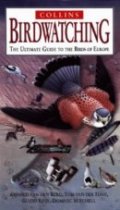
|
|
Habitats for Birds in Europe: A Conservation Strategy for the Wider EnvironmentEditors: Graham M. Tucker and Michael I. Evans
BirdLife Conservation Series 6
BirdLife International
1997
"The greatest threats to Europe's birds and biodiversity come from loss and degradation of habitat. This book brings together more than 190 bird and habitat conservation experts from all over Europe, to examine the threats to Europe's eight major habitat types, and propose policies and actions to protect and restore them. Although the emphasis is on birds, particularly the 40 percent of European species with an unfavourable conservation status, many recommendations would help conserve all elements of biodiversity in the wider European environment."
|
Buy from amazon.co.uk 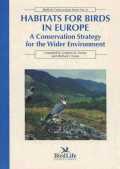
|
|
Birds of EuropeLars Jonsson
Christopher Helm
1996
"Originally produced in five volumes, this practical guide covers all but a few of the Western Palearctic's breeding birds. The guide has species accounts, distribution maps and illustrations on facing pages for easy reference. By the author of "Birds of the Mediterranean and Alps."
|
Buy from amazon.co.uk 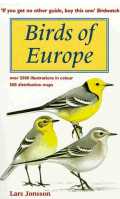
|
|
The Macmillan Birder's Guide to European and Middle Eastern BirdsAlan Harris, Hadoram Shirihai and David Christie
Macmillan
1996
"A guide to European and Middle Eastern species. The clearly written text is accompanied by 80 plates of exquisite illustrations and hand-written captions."
|
Buy from amazon.co.uk 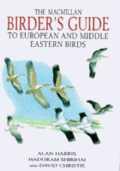
|
|
Birds of Britain and Europe with North Africa and the Middle EastHermann Heinzel, Richard Fitter, and John Parslow
Collins
1995
A guide that describes and illustrates all 887 species of birds found in Britain and Europe including all rarities and introduced species. The book provides the information needed to identify every species - whatever its age or sex - and special pages highlight groups of birds that are difficult to identify.
|
Buy from amazon.co.uk 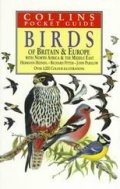
|
|
Birds in Europe: Their Conservation StatusG.M. Tucker, M.F. Heath, L. Tomialojc and R.F.A. Grimmett
BirdLife Conservation Series 3
BirdLife International
1994
"This milestone publication presents the first thorough and detailed review of the conservation status of European birds. Based on detailed breeding and wintering population data collected in each country, the report provides a review of the population sizes and trends of Species of European Conservation Concern. The major threats to each species are discussed, with the basic measures that are needed to conserve them and their habitats."
|
Buy from amazon.co.uk 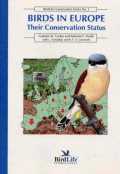
|
|
Birds of Europe: With North Africa and the Middle EastLars Jonsson
Princeton University Press
1993
|
Buy from amazon.co.uk 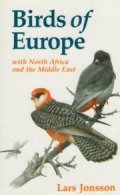
|
|
Birds of Britain and EuropeRoger Tory Peterson, Guy Mountford, P.A.D. Hollom,
Collins Field Guides
Collins
Published in the US by Houghton Mifflin as a Peterson Field Guide
1993
"This fifth edition is a guide to the birds of Britain and Europe. The book includes an update of the maps and revision of the illustrations to help in the identification of wild birds."
|
Buy from amazon.co.uk 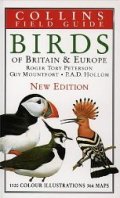
Buy from amazon.co.uk
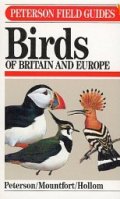
|
|
Identification Guide to European Non-PasserinesKevin Baker
BTO
1993
"A major guide, which complements Lars Svensson's Identification Guide to European Passerines. It covers 119 species, with descriptions of ageing and sexing methods, moult, biometrics and racial differences, making it an invaluable tool for ringers and museum workers, as well as keen birders."
|
Buy from amazon.co.uk 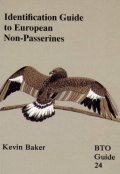
|
|
Identification Guide to European PasserinesLars Svensson
BTO
1992
"The ringer's bible is completely revised and updated to include 229 species, with valid subspecies, of passerines regularly occurring in Europe, plus some rare vagrants. Data include wing formulae, measurements, plumage, and other criteria for determining sex and age. It also includes indices of English, Finnish, French, German and Swedish names."
|
Buy from amazon.co.uk 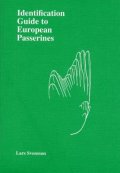
|
|
The Hamlyn Guide to Birds of Britain and EuropeBertel Brunn, Hakan Delin and Lars SvenssonIllustrations: Arthur Singer and Dan Zetterstrom
Hamlyn
1989
The complete guide to Europe's birds. 516 birds in colous. 448 maps.
|
Buy from amazon.co.uk 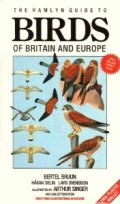
|
|
Conservation of Seabirds in the North SeaMark L. Tasker
Joint Nature Conservation Committee
1989
|
Buy from amazon.co.uk 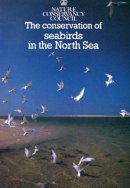
|
|
Seabirds in the North SeaMark L. Tasker
Nature Conservancy Council
1986
|
Buy from amazon.co.uk 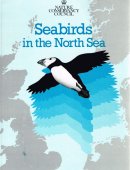
|
|
A Field Guide To Birds of Britain and EuropeRoger Tory Peterson, Guy Mountford, P.A.D. Hollom,
Collins
1983
Fourth edition. "Precise field identification of every species occurring in Europe. 1195 colour illustrations. 361 distribution maps."
|
Buy from amazon.co.uk 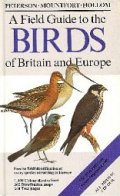
|
|
Birds of the Mediterranean and AlpsLars Jonsson
Editor: Iain Robertson & Mark Beaman
Croom Helm
1982
"This is the fifth book in the series covering a variety of habitat and natural environments in Europe. This book focuses mainly on the European countries found along the Mediterranean, but a few birds found only around Turkey and southwards are included, such as the Black-headed (aka, White-spectacled) Bulbul. Not all birds found near the Mediterranean are included. To keep the size of the book smaller, the author included a selection of 160 birds typically not found in the northern parts of Europe."
|
Buy from amazon.co.uk 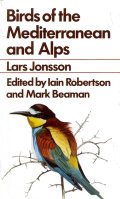
|
|
The Breeding Birds of Europe 2: Sandgrouse to CrowsManfred Pforr and Alfred Limbrunner
Croom Helm
1982
A photographic handbook.
|
Buy from amazon.co.uk 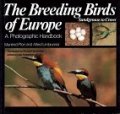
|
|
The Breeding Birds of Europe 1: Divers to AuksManfred Pforr and Alfred Limbrunner
Croom Helm
1981
A photographic handbook.
|
Buy from amazon.co.uk 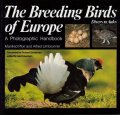
|
|
A Field Guide To Birds of Britain and EuropeRoger Tory Peterson, Guy Mountford, P.A.D. Hollom,
Book Club Associates
1974
Third edition. "Precise field identification of every species occurring in Europe. 1225 illustrations, 695 in colour. 384 distribution maps."
|
Buy from amazon.co.uk 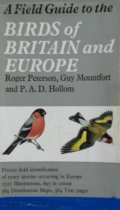
|
|
The Hamlyn Guide to Birds of Britain and EuropeBertel Brunn and Arthur Singer
Hamlyn
1972
The complete guide to Europe's birds. 516 birds in colous. 448 maps.
|
Buy from amazon.co.uk 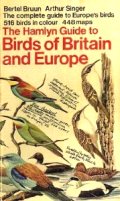
|
|
Birds of EuropeBertel BrunnIllustrations: Arthur Singer
Golden Press / McGraw Hill
1971
There were a number of editions of this book roughly in the 1969-1971 period.
|
Buy from amazon.co.uk 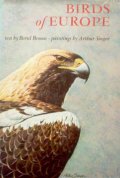
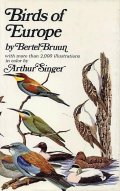
|
|
The Birds of the Palearctic Fauna
Non Passeriformes
Charles Vaurie
H.F. & G. Witherby
1965
"Dr Vaurie of the American Museum of Natural History has spared no effort in compiling his systematic list, of which this is the second volume of two. The book is designed to list all the birds that breed in the palearctic region, arranged in sequence. 559 species are included, with full notes about the range of the birds, their breeding grounds and migratory habits. Includes some descriptions and measurements of birds."
|
Buy from amazon.co.uk 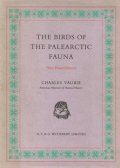
|
|
Atlas of European Birds
K.H. Voous
Nelson & Co
1960
|
Buy from amazon.co.uk 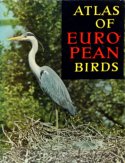
|
|
The Birds of the Palearctic Fauna
Passeriformes
Charles Vaurie
H.F. & G. Witherby
1959
"Dr. Vaurie's new work gives for every Passerine species (the non-Passerines are to be the subject of a second volume) concise details of range, habitat, subspecies, and geographical variation. English, French, and German vernacular names are also given where designated. The inclusion of habitat details has seldom before been considered in a systematic reference of this kind but they form an important part of the work, for it is impossible to divorce birds from general ecology. For the ornithologist who wishes to view the Palearctic avifauna as a whole, Dr. Vaurie's book will prove an invaluable reference. It should prove a standard work on the Passerine birds of this vast region for many years to come."
|
Buy from amazon.co.uk 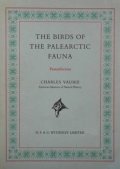
|
|
Guide To The Birds Of Europe And North AfricaColonel R.G. Wardlaw
Biographical memoir: William Eagle Clarke
Gurney And Jackson
1923
From the preface: Several years previous to his death, Colonel Wardlaw Ramsay, realising that a concise pocket "Guide to the Birds of Europe and North Africa" was a great desideratum, devoted much time to the preparation of such a work, and on many occasions consulted me on various matters as it progressed. A few days before he passed away he had premonitions that his end was near and said to me as I sat beside him, "If I do not pull through this illness, I leave my unfinished book to you quite unconditionally: publish it or not as you think best." On examination, the draft manuscript was found to be practically complete so far as the descriptions of the various species and racial forms, and their geographical distribution, were concerned; but otherwise much remained to be done before the work would be in a state to send to the Press. Being engaged on other ornithological work at the moment, it was unfortunately impossible for me to give the necessary attention to the "Guide," but on mentioning the situation to my friend Surgeon-Rear-Admiral Stenhouse, M.B.O.U., he at once kindly volunteered to help me, and it is entirely due to his valued co-operation that this work has so promptly appeared.
|
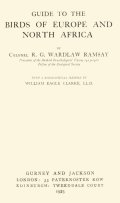
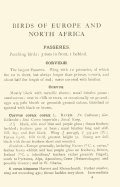 |
|
A Manual Of Palearctic BirdsH.E. Dresser
Published by the author
Part I: 1902
Part II: 1903
From the preface: Twenty years ago, when the Birds of Europe was nearing its end, I thought of issuing a similar work on the Birds of Northern Asia, in order to furnish a complete account of the Ornithology of the Palearctic Region. It seemed, however, that I could not expect to obtain for my project the support of a sufficient number of subscribers to save me from serious pecuniary loss, and with much regret the project had to be abandoned. I have since been urged by many friends to bring out a Handbook of European Birds, of a size, and at a price, which would be convenient to travellers and field-naturalists the latter being a class of persons with whom, for the sake of old associations, when I counted myself one of them, I have still the greatest sympathy. Bearing in mind, however, my former desire to treat of the Birds of Northern Asia, and knowing how non-existent is any physical barrier between the Eastern and Western portions of the Palearctic area, I have thought it expedient not to limit the present Manual to European species, even with the addition of those of Barbary and the Atlantic Islands (Madeira, Canaries, and Azores).
|
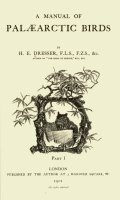
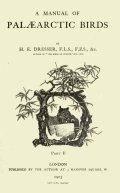
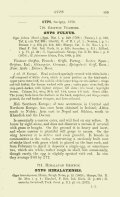 |
|
A List Of European Birds, Including All Those Found In The Western Palaearctic AreaWith a supplement containing species said to have occurred but which, for various reasons, are inadmissableHeatley Noble
R.H. Porter
1898
Introduction: As there is no list of European Birds up to date, it is hoped that the following may be of use to collectors, for reference and exchange of skins and eggs, also for labelling specimens, especially as the Supplement contains a list of those birds of disputed occurrence, printed in the same type, a feature not found in any other work of the kind. My thanks are due to many friends for their kind assistance, and especially to Mr. Dresser, for permitting me to use his "List of European Birds."
|
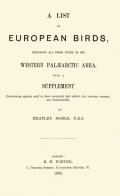
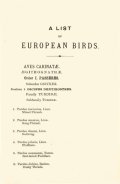 |
|
Supplement To A History Of The Birds Of Europe Forming Volume IX
Additional Species Found To Occur In The Western Palearctic Area
Henry E. Dresser
Illustrations: J.G. Keulemans, J. Wolf, E. Neale, and others
Published by the author
1895-1896
From the preface: "Since the completion of the 'Birds of Europe,' I have several times contemplated the issue of a Supplement, but have deferred so doing until I had collected sufficient material to make a volume at least as large as any one of those forming the original work. It was suggested to me by more than one subscriber that I should revise each article in the original work, bringing the same up to date; but I found that a thorough revision, adding all the material that has since accumulated, would fill at least three if not four volumes, and that it would really be tantamount to bringing out a new edition, and I have therefore preferred merely to treat of such species as have to be added to those in the original work, and should a new edition be required I shall probably issue the same in the form of a concise handbook, condensing the information into as small a space as possible."
|
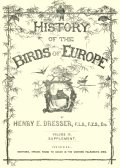
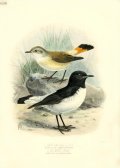
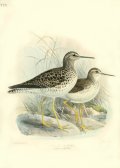 |
|
A List Of European Birds Including All Species Found In The Western Palearctic RegionHenry E. Dresser
Published by the author
1881
Introduction: "Several of the Subscribers to my 'Birds of Europe' have urged me to publish a List of the Birds of the "Western Palearctic Region, as a check-list for labelling, and for reference in making exchanges of birds and eggs; and as no such list already existed, I hope that the present one may prove useful. I have, as will be seen, followed Professor Huxley's classification, which appears to me to be the best that has yet been elaborated, which classification I have adopted in the 'Birds of Europe;' and in order to facilitate reference, the species are numbered consecutively, as has been done in that work. A few alterations in the nomenclature, which further research has proved to be necessary, have been made."
|
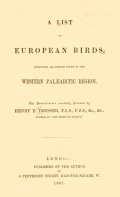
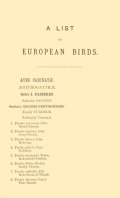 |
|
A History Of The Birds Of EuropeH.E. Dresser
Illustrations by J.G. Keulemans, Joseph Wolf, E. Neale, and others
Published by the author
1871 to 1881
Published originally in 84 parts and then in 8 volumes. The History covers all the birds of the Western Palearctic. A supplemental volume was published in 1896. For more detail about this publication see the A History Of The Birds Of Europe.
|
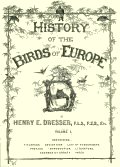
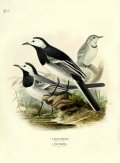
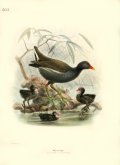 |
|
A History Of The Birds Of Europe, Not Observed In The British IslesVolume I to IVC.R. Bree
238 colour plates: Benjamin Fawcett
Groombridge And Sons
1863-4
Originally published in 60 or more parts from 1859 onwards. A four volume edition was published in 1863 and 1864. A second, five volume, edition was published in 1875 to 1876.
From the preface: After five years of considerable toil and anxiety I have brought this work to a conclusion, and it becomes my pleasing duty to say a few words to my subscribers upon some points of interest connected with it. When I undertook to publish a "History of the Birds of Europe, not Observed in the British Isles," I was impressed with the value and importance of such a work to all who are interested in British ornithology. The birds of our own islands had already been well illustrated and their histories copiously written in the works of Montagu, Lewin, Bewick, Selby, Macgillivray, Meyer, Yarrell, and Morris, but with the exception of the splendid work of Mr. Gould, there were none accessible to the great mass of ornithologists upon the remaining Birds or Eggs of Europe. 1 felt that this was a great blank which ought to be filled up, and I ventured to undertake the task. But I must candidly confess that, when I consented to do this, I was not aware of the magnitude and difficulty of the work I had undertaken. As Professor Schlegel remarked to me in one of his letters, "A History of the Birds of Europe is a very different thing now from what it would have been ten years ago." This of course arises from the great extension of ornithology as a science, and a more general study of the avi-fauna of different countries, especially of those which impinge upon the other great divisions of the world - the border districts of Africa and Asia. Having, however, fairly engaged in my work, I was determined not to be discouraged, but to carry out the scheme to a successful issue. This I have done. How, it must be for others, not me to say. I am quite conscious of my own shortcomings, but I have at least, I think, accomplished a work which will be useful to my brother naturalists, and not entirely without influence in promoting the advancement of European ornithology.
|
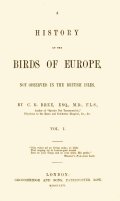
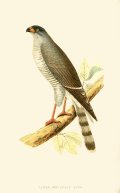
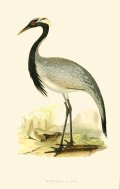 |
|
The Birds Of EuropeVol. I: RaptoresJohn Gould
Colour plates: John Gould, Elizabeth Gould, Edward Lear
Published by the author
1837
This is the first volume of the five volume Birds Of Europe which was originally published in 22 parts between 1832 and 1837.
From the preface: "It has been frequently remarked that the productions of distant countries have received a much larger share of attention than those objects by which we are more immediately surrounded; and it is certainly true, that while numerous and costly illustrations have made us acquainted with the Ornithology of most other parts of the world, the Birds of Europe, in which we are, or ought to be, most interested, have not received that degree of attention which they naturally demand. The present work has been undertaken to supply this deficiency, and I cannot but feel highly gratified that a number of concurring circumstances have enabled me to carry my intentions into effect with comparative facility, and I hope to the entire satisfaction of the whole of the Subscribers; this I am induced to believe is the case from the patronage with which the work has been honoured since its commencement. .....Perhaps I may be allowed to add, that not only by far the greater number of the Plates of this work, but all those of my Century of Birds, of the Monograph of the Trogons, and at least three fourths of the Monograph of the Toucans have been drawn and lithographed by Mrs. Gould, from sketches and designs by myself always taken from nature. The remainder of the drawings have been made by Mr. Lear, whose abilities as an artist are so generally acknowledged that any comments of my own are unnecessary.
|
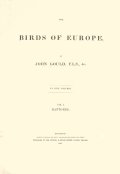
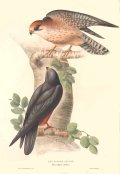
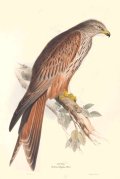 |
|
The Birds Of EuropeVol. II: InsessoresJohn Gould
Colour plates: John Gould, Elizabeth Gould, Edward Lear
Published by the author
1837
This is the second volume of the five volume Birds Of Europe which was originally published in 22 parts between 1832 and 1837.
|
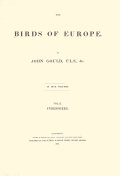
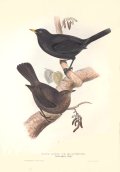
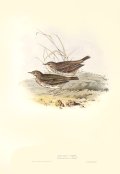 |
|
The Birds Of EuropeVol. III: InsessoresJohn Gould
Colour plates: John Gould, Elizabeth Gould, Edward Lear
Published by the author
1837
This is the third volume of the five volume Birds Of Europe which was originally published in 22 parts between 1832 and 1837.
|
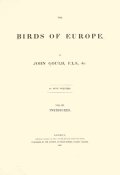
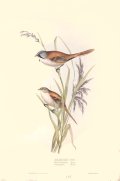
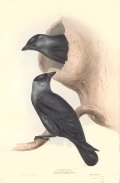 |
|
The Birds Of EuropeVol. IV: Rasores, GrallatoresJohn Gould
Colour plates: John Gould, Elizabeth Gould, Edward Lear
Published by the author
1837
This is the fourth volume of the five volume Birds Of Europe which was originally published in 22 parts between 1832 and 1837.
|
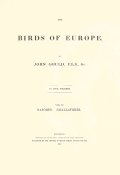
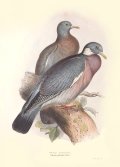
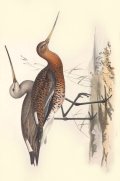 |
|
The Birds Of EuropeVol. V: NatatoresJohn Gould
Colour plates: John Gould, Elizabeth Gould, Edward Lear
Published by the author
1837
This is the fifth volume of the five volume Birds Of Europe which was originally published in 22 parts between 1832 and 1837.
|
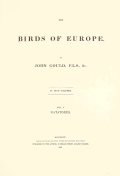
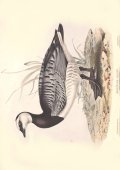
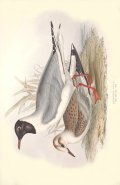 |
|